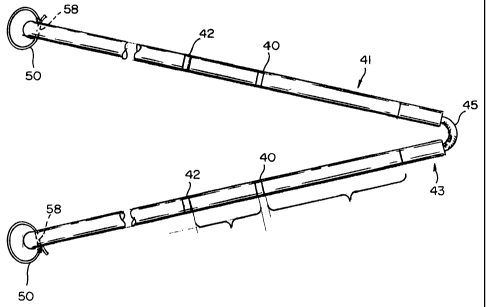Some of the information on this Web page has been provided by external sources. The Government of Canada is not responsible for the accuracy, reliability or currency of the information supplied by external sources. Users wishing to rely upon this information should consult directly with the source of the information. Content provided by external sources is not subject to official languages, privacy and accessibility requirements.
Any discrepancies in the text and image of the Claims and Abstract are due to differing posting times. Text of the Claims and Abstract are posted:
| (12) Patent: | (11) CA 2475814 |
|---|---|
| (54) English Title: | IMPROVED JOUSTING APPARATUS |
| (54) French Title: | APPAREIL DE JOUTE AMELIORE |
| Status: | Expired |
| (51) International Patent Classification (IPC): |
|
|---|---|
| (72) Inventors : |
|
| (73) Owners : |
|
| (71) Applicants : |
|
| (74) Agent: | RIDOUT & MAYBEE LLP |
| (74) Associate agent: | |
| (45) Issued: | 2008-04-29 |
| (86) PCT Filing Date: | 2003-02-10 |
| (87) Open to Public Inspection: | 2003-08-21 |
| Examination requested: | 2004-12-03 |
| Availability of licence: | N/A |
| (25) Language of filing: | English |
| Patent Cooperation Treaty (PCT): | Yes |
|---|---|
| (86) PCT Filing Number: | PCT/US2003/003953 |
| (87) International Publication Number: | WO2003/068337 |
| (85) National Entry: | 2004-08-10 |
| (30) Application Priority Data: | ||||||
|---|---|---|---|---|---|---|
|
The improved jousting apparatus includes two sticks (41, 43) which are joined
together with a flexible rope-like connecting member (45) which is anchored
within the ends of the respective sticks. The connecting member is long enough
to allow motion of the two sticks relative to each other. Each stick includes
two positioning rings (40, 42) along the length thereof, the upper ring
identifying a normal position for the upper hand of each contestant, the first
and second rings together identifying a first disadvantaged position for a
selected contestant, and the second ring identifying a further disadvantaged
position for the selected contestant.
L'invention concerne un appareil de joute am~lior~ comprenant deux b~tons (41, 43) assembl~s au moyen d'un ~l~ment de connexion souple de type corde (45), ancr~ dans les extr~mit~s des b~tons respectifs. L'~l~ment de connexion est suffisamment long pour permettre un mouvement des deux b~tons l'un par rapport ~ l'autre. Le long de chaque b~ton se trouvent deux anneaux de positionnement (40, 42), l'anneau sup~rieur identifiant une position normale pour la main sup~rieure de chaque concurrent, les premier et second anneaux identifiant ensemble une premire position d~favoris~e pour un concurrent s~lectionn~ et le second anneau identifiant une autre position d~favoris~e pour le concurrent s~lectionn~.
Note: Claims are shown in the official language in which they were submitted.
Note: Descriptions are shown in the official language in which they were submitted.

For a clearer understanding of the status of the application/patent presented on this page, the site Disclaimer , as well as the definitions for Patent , Administrative Status , Maintenance Fee and Payment History should be consulted.
| Title | Date |
|---|---|
| Forecasted Issue Date | 2008-04-29 |
| (86) PCT Filing Date | 2003-02-10 |
| (87) PCT Publication Date | 2003-08-21 |
| (85) National Entry | 2004-08-10 |
| Examination Requested | 2004-12-03 |
| (45) Issued | 2008-04-29 |
| Expired | 2023-02-10 |
There is no abandonment history.
| Fee Type | Anniversary Year | Due Date | Amount Paid | Paid Date |
|---|---|---|---|---|
| Application Fee | $200.00 | 2004-08-10 | ||
| Maintenance Fee - Application - New Act | 2 | 2005-02-10 | $50.00 | 2004-12-01 |
| Request for Examination | $400.00 | 2004-12-03 | ||
| Maintenance Fee - Application - New Act | 3 | 2006-02-10 | $50.00 | 2005-12-02 |
| Maintenance Fee - Application - New Act | 4 | 2007-02-12 | $50.00 | 2006-12-11 |
| Final Fee | $150.00 | 2007-12-03 | ||
| Maintenance Fee - Application - New Act | 5 | 2008-02-11 | $100.00 | 2008-02-01 |
| Maintenance Fee - Patent - New Act | 6 | 2009-02-10 | $100.00 | 2008-12-05 |
| Maintenance Fee - Patent - New Act | 7 | 2010-02-10 | $100.00 | 2009-11-19 |
| Maintenance Fee - Patent - New Act | 8 | 2011-02-10 | $100.00 | 2011-01-14 |
| Maintenance Fee - Patent - New Act | 9 | 2012-02-10 | $100.00 | 2012-02-10 |
| Maintenance Fee - Patent - New Act | 10 | 2013-02-11 | $125.00 | 2012-10-22 |
| Maintenance Fee - Patent - New Act | 11 | 2014-02-10 | $125.00 | 2013-12-11 |
| Maintenance Fee - Patent - New Act | 12 | 2015-02-10 | $125.00 | 2014-10-02 |
| Maintenance Fee - Patent - New Act | 13 | 2016-02-10 | $125.00 | 2016-02-08 |
| Maintenance Fee - Patent - New Act | 14 | 2017-02-10 | $125.00 | 2017-02-09 |
| Maintenance Fee - Patent - New Act | 15 | 2018-02-12 | $225.00 | 2018-01-11 |
| Maintenance Fee - Patent - New Act | 16 | 2019-02-11 | $225.00 | 2019-02-04 |
| Maintenance Fee - Patent - New Act | 17 | 2020-02-10 | $225.00 | 2020-02-07 |
| Maintenance Fee - Patent - New Act | 18 | 2021-02-10 | $229.50 | 2021-01-15 |
| Maintenance Fee - Patent - New Act | 19 | 2022-02-10 | $229.04 | 2022-02-09 |
Note: Records showing the ownership history in alphabetical order.
| Current Owners on Record |
|---|
| HEGLUND, ALBERT JUNIOR |
| Past Owners on Record |
|---|
| None |